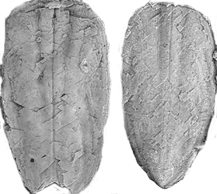 |
|
||||||
|
Genus Dignomia Hall, 1871 |
| [Type-species = Lingula alveata] |
|
Shell thin, elongate oval in shape; externally, two diverging medio-lateral grooves (internally ridges) extend from the umbonal region to the anterior margin, and a narrow median groove (a septum internally) extends from the umbonal region to the anterior margin of the dorsal valve but in the ventral valve only over the anterior half of the shell. Asymmetrical muscle system with three internal oblique muscles; unpaired posterior adductor muscle; no vascula media observed. (Note: these three characters are prerequisite to a diagnosis of the Family Lingulidae – see Emig 2003). |
| Middle Ordovician to Middle Devonian Occurrences: North and South America. Diagnosis from Emig & Herrera (2006) |
|
|
|
The references for this page are:
|
|
Lingula submarginata d'Orbigny, 1850 (pro Lingula marginata d'Orbigny, 1842: p. 28, Pl. 2 fig.5; non Phillips, 1836): p. 14; Lingula lineata Hoek, 1912, in Steinman & Hoek, 1912: p. 232; Dignomia boliviana Emig, 1996, in Gagnier et al. (1996): p. 338, Fig. 6. Holotype: none. Syntypes a dorsal and a ventral valve from Zudáñez (= Tacopaya), Chuquisaca region (MNHN R06654). Diagnosis - (Emig & Herrera 2006) including the figure in front The outline of the shell is an elongate oval. Two large medio-lateral grooves, longitudinally striated, extend from the umbonal region to the anterior margin of the valves; a median groove is narrow. On the outer surface of the dorsal valve is a median groove that occupies its whole length. On the ventral valve, the groove extends from the anterior margin to about the half to two-thirds of the length. |

Dorsal & ventral valves

Ventral valve |
